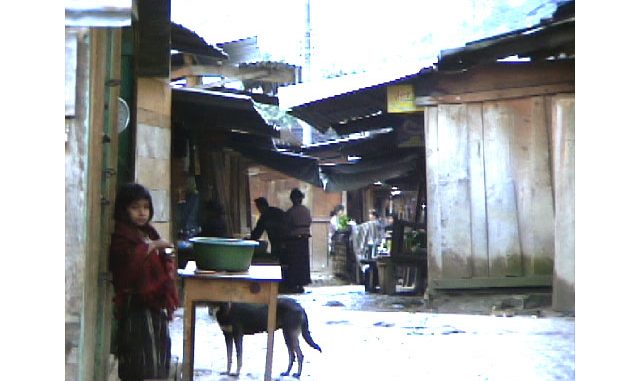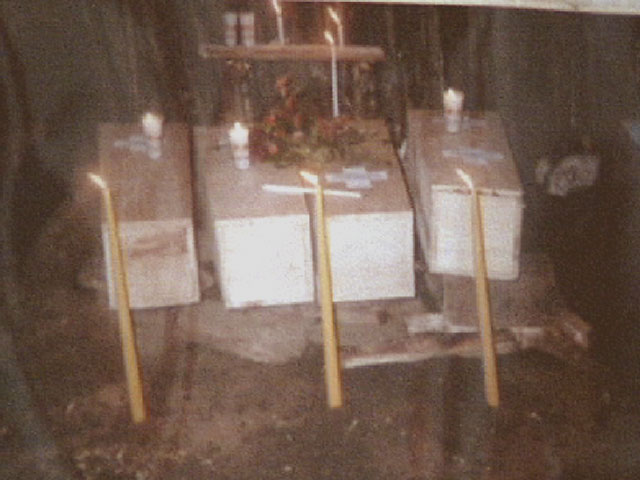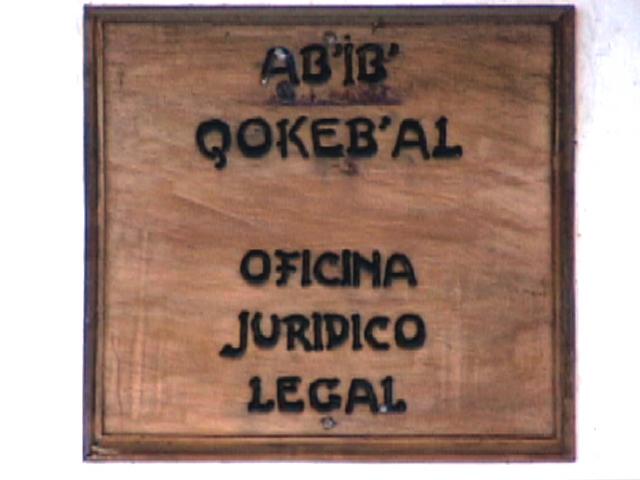
Chajul is a remote indigenous town in the Ixil triangle, about 150Km. north of Antigua in Guatemala. Ixil is an area of east-west valleys surrounded by higher mountain peaks. It is home to the Ixil people, a group of related Mayan tribes. Though their Mayan dialects are linguistically related, the people of Chajul find the language spoken in capital Nebaj incomprehensible. Nebaj is just 25K down the road.
The arrival of a regular chicken bus service and the recent road improvements has little altered the lives of the people of Chajul (Chajulense). Private cars are virtually unknown and many locals have never been outside Ixil. Most employment is in agriculture and services. In the surrounding countryside men and women can be seen carrying tremendous loads over long distances. The men and children carry Maize, coffee, firewood and building materials tied by rope in a bundle attached by a strap to their foreheads. The women balance smaller loads on their heads such as baskets of clothing washed by hand in the river. Other employment includes care for livestock: mainly cattle, fowl and pigs. Urban employment is mainly in retail, selling locally made or Chinese goods in small shops (tiendas) or markets stalls. Other employment includes artisan trades, and transport work: mainly mechanical repairs, and driving local buses, trucks or pickups.
Recently an indigenous industry has sprung up under the auspices of the co-operative movement. The “Association Chajulense” has two small factories in the food-manufacturing sector, one producing coffee and the other cheese all from locally sourced raw materials. Tourism industry development is also in advanced stages but the remoteness of the village and transportation issues means that the luxury hotel designed and built by local carpenters is often underutilized or used to house engineers working in the cheese plant.
Many women practice handcrafts outside their spacious one-room dirt floored houses. Most of this work involves the weaving of colorful traditional clothing. Each village in Guatemala has its own distinctive clothing style. In Chajul the women wear a simple red or brown striped skirt cut below the knee, woven cloth belts and a range of colorfully embroidered tuck-in blouses: white for feast days and various shades of burgundy the rest of the year. Again most source materials are made in the village.
Life was not always so idyllic in Chajul. The Ixil region was one of the epicenters of the Guatemalan 36-year war of insurgency and repression. 1982 and 1983 were the years of the fiercest fighting as government troops ruthlessly wrestled control of the region. ‘The General’, President Ríos Montt commanded the troops at this time investing public funds in expanding the armed forces by 50%. Montt came into power (via a coup) in 1982 and ruled with an iron fist for two years. He now faces genocide charges in multiple jurisdictions. The people of Chajul are anxious for justice.
Chajul town square in front of the parish church was the scene of the torture to death of Patrocino Menchu the brother of Rigoberta Menchu. An excerpt from her book “I Rigoberta Menchu” describes the event:
‘My name is Rigoberta Menchu Tum. l am a representative of the “Vincente Menchu” [her father] Revolutionary Christians … On 9 December 1979, my 16-year-old brother Patrocino was captured and tortured for several days and then taken with twenty other young men to the square in Chajul … An officer of [President] Lucas Garcia’s army of murderers ordered the prisoners to be paraded in a line. Then he started to insult and threaten the inhabitants of the village who were forced to come out of their houses to witness the event. I was with my mother, and we saw Patrocino; he had had his tongue cut out and his toes cut off. The officer jackal made a speech. Every time he paused the soldiers beat the Indian prisoners. When he finished his ranting, the bodies of my brother and the other prisoners were swollen bloody, unrecognizable. lt was monstrous, but they were still alive. They were thrown on the ground and drenched with gasoline. The soldiers set fire to the wretched bodies with torches and the captain laughed like a hyena and forced the inhabitants of Chajul to watch. This was his objective-that they should be terrified and witness the punishment given to the “guerrillas”. – Rigoberta Menchu Tum

The townspeople were forced to watch the torture under threat of being branded ‘Communists’ and sharing a similar fate. Rigoberta has devoted her life to healing the wounds of this war and has accepted a strategic position in the new Guatemalan Government formed in January 2004 under president Oscar Berger. She also won the 1992 Nobel peace prize for her work. There were more than twenty massacres in the Ixil region, most during the two-year period of Montt’s bloody rule. The victims were largely Ixil villagers and insurgent forces but there are also mass graves of government troops. Among the victims was the Father Jose Maria Gran Cirera shot just outside Chajul on June 4, 1980.

Baltazar Raymundo Riviera presides over the Chajul “Officina Juridicio Legal”, the local office of human rights. This one-man office is situated just beside the parish church in what was once the barracks of the government troops before the townspeople forced out the government troops. His walls are covered with posters, maps and photographs with a common theme: the posters depict assassinated bishops and priests and collages of the faces of family members of the disappeared. Of particular interest are amateur 35mm. photographs arranged in three collages; these depict recent exhumations of victim’s bodies out of mass graves across the Ixil region. This task is coordinated from his office as are the burials of these remains by survivors.
Baltazar’s association has been coordinating the disinterment and subsequent burial of more than 200 victim’s. The mass graves are located in more than 20 sites in Ixil. Many volunteers involved in the digging, labeling and transportation of remains are relatives and friends of the deceased. Where possible relatives of the deceased carry the coffins to their final resting places after they are identified in the pathology lab. Baltazar’s diary is filled with the grueling details of exhumation schedules, shipment dates of corpses to forensic laboratories and the scheduling of the decent interment of the remains of the victims some twenty years after they have been slain.The scars of war are deep but with the courageous efforts of people like Baltazar there is hope for the Ixil people. The recent appointment of Rigoberta Menchu as “good will ambassador to the peace accord” in the Berger Government is encouraging for determined individuals like Mr. Riviera. However his efforts did not wait for her appointment. Human rights work has survived through various less-friendly regimes for more than 10 years now.
The parallel development of the financial projects of the Association Chajulense is also a source for hope for the people of the region. The Ixil coffee brand made in Chajul is sold mainly in the German and Dutch markets as a premium organic product bringing much needed development income. The success of the Association Chajulense is touted as a prime example of recovery and progress in Guatemala.
It is ironic to think that the children forced to watch the brutal torture in the square some twenty years back under threat of being branded ‘Communist’ grew up to become adept community Socialists!

Leave a Reply